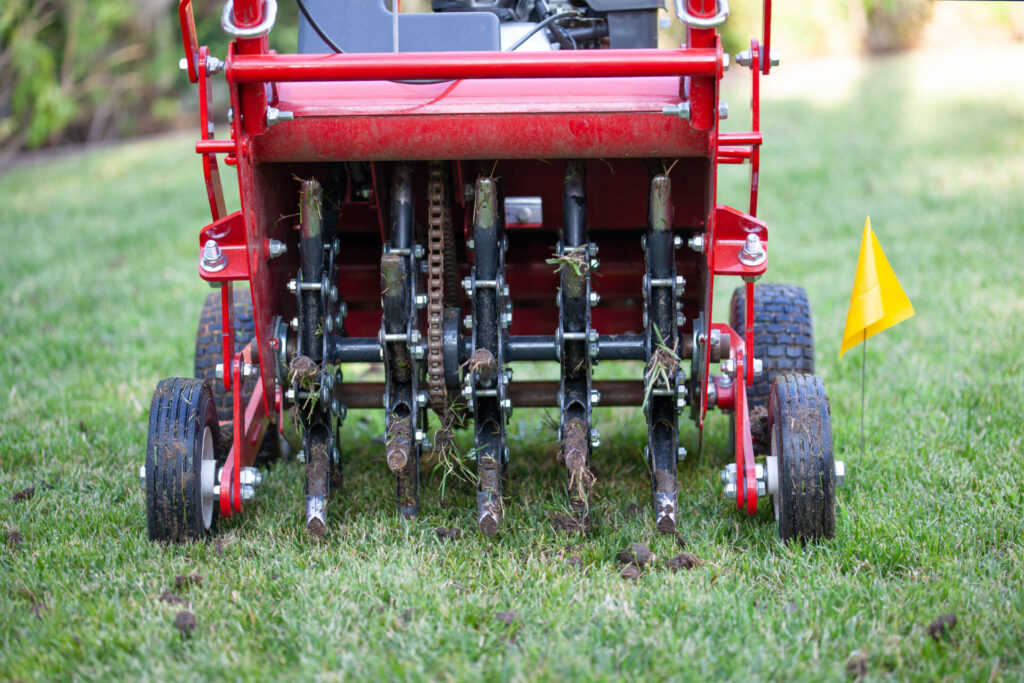Maintaining a strong, dense lawn requires targeted seasonal care. Two essential practices for turf health are aeration and overseeding.
Aeration involves perforating the soil with small holes to allow air, water, and nutrients to reach the roots. Meanwhile, overseeding is the process of spreading grass seed over an existing lawn to improve its density and appearance. Together, these practices enhance soil health, promote thicker grass growth, and help lawns recover from stress caused by heat, drought, or heavy foot traffic.
That said, timing and technique are crucial to achieving optimal results. Here’s a breakdown of when and how to aerate and overseed your lawn to achieve stronger, healthier grass year-round.
When To Aerate and Overseed
Fall is the best time for both aeration and overseeding, especially in regions that grow cool-season grasses, such as Kentucky bluegrass and perennial ryegrass. During this period, the soil remains warm enough to promote seed germination, while the cooler air temperatures reduce stress on young grass.
For warm-season grasses like Bermuda or zoysia, the most suitable time is early spring to early summer, when growth is most active. However, regional climate and weather patterns may affect the best timing. Ideal conditions include:
- Mild daytime temperatures (60–75°F for cool-season, 80–95°F for warm-season)
- Soil that is moist but not soggy
- Recent rainfall or light watering to soften the ground before aerating
In addition to seasonal timing, you should consider aeration and overseeding if your lawn shows signs such as:
- Water pools on the surface after rain
- Grass looks thin or patchy
- Soil feels hard or compacted
- Heavy foot traffic or the use of heavy equipment
- Excessive thatch buildup (more than ½ inch)
Even healthy lawns benefit from periodic aeration to maintain soil structure and reduce compaction.
How To Aerate and Overseed Your Lawn
Here are the key steps to follow during aeration and overseeding for best results:
1. Mow Your Lawn Short
Start by cutting the grass down to about 1.5 to 2 inches. This helps ensure the new seed reaches the soil instead of getting caught in taller grass. It also enhances light exposure and seed-to-soil contact, which are both important for germination.
2. Water Lightly the Day Before
Moist soil allows the aerator to work more effectively. You can either water the lawn lightly the day before or time the process after a light rainfall. The goal is to soften the soil without making it muddy or soggy.
3. Aerate the Lawn
Use a core aerator to remove small plugs of soil across the lawn, paying special attention to compacted or worn areas. These openings allow air, nutrients, and moisture to reach the roots more easily, creating a better environment for new and existing grass.
4. Choose the Right Grass Seed
Select a grass seed variety that suits your climate and matches your existing lawn. For best results, look for varieties that are disease-resistant, drought-tolerant, and suited to your lawn’s sun and shade conditions.
5. Spread the Seed Evenly
Use a broadcast or drop spreader to apply seed across the lawn. For best results, make two passes in opposite directions to avoid gaps and ensure even distribution.
6. Top-Dress Lightly
After seeding, apply a thin layer of compost or screened topsoil. This layer protects seeds from birds and wind, retains moisture, and encourages better seed-to-soil contact. Avoid heavy topdressing, as it may bury the seed too deeply and prevent it from sprouting.
Aftercare Tips
These tips will help protect new seedlings and support long-term lawn health.
- Avoid mowing. Early cutting can damage delicate seedlings. Hold off on mowing for two to three weeks, or until new grass reaches a mowing height of about three inches.
- Limit foot traffic. Keep people and pets off the lawn during the first few weeks. Repeated pressure can compact soil and disturb sprouting grass.
- Fertilize cautiously. Use a starter fertilizer to support early root growth, but avoid overapplication. Excessive nitrogen can harm young grass or promote weed growth.
Boost Lawn Growth With Well Rooted Gardens’ Aeration and Overseeding Expertise
Aeration and overseeding require planning, time, and labor. For homeowners who want guaranteed results without the hassle, look no further than Well Rooted Gardens!
With over 15 years of experience serving the Omaha area, our team delivers expert lawn maintenance and restoration services. We implement proven techniques and use premium grass seed to enhance turf density, support healthy root development, and elevate overall curb appeal.
Call 402-800-7389 or contact us to schedule a consultation today!

